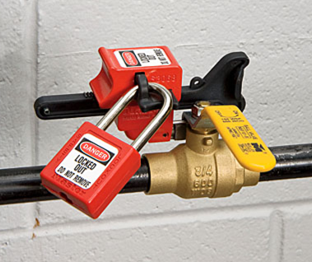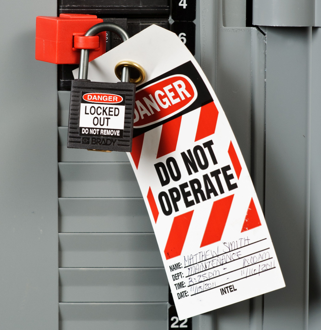Tackling OSHA’s Top 10 Citations: 1910.147 - Lockout/Tagout

The sixth most cited hazard by OSHA in Fiscal Year 2022 is lockout/tagout or Control of Hazardous Energy (lockout/tagout), general industry (29 CFR 1910.147). Lockout/Tagout has been in the Top 10 Most Frequently Cited OSHA Standards for years and it’s worth focusing on in depth with HSI’s Chief Safety Officer, Jill James.

A fallacy that people often think is that we lock out energy sources when something is broken. And that's true, and it certainly can happen at that time, but it's also about when employees are going to do maintenance, repair work, dig into the inner workings of something where there could be an energy source or multiple sources that could harm them.
Stored energy could be what we're seeing in the top photo. Maybe it's a valve that has a gas, or a liquid, or a water source, or perhaps it's a valve like you're seeing in the picture below.

There are a lot of different devices that are manufactured to make it impossible for people to turn something on, and put someone else in jeopardy. There are a lot of different things on the market, and methods to use, to physically turn off and lock out the energy source.

Everyone's probably most familiar with the image of locking out the typical breaker panel (like the above photo), but there are many different energy sources; electrical, gas, pneumatics, water, and even gravity. The picture below is a device that's used to lock out gravity sources.

If you think about something that's held aloft, that could fall or crush onto someone, often you'll see that with rams, maybe in a punch press situation.
A real-world example is a workplace fatality I investigated where a man was under a truck. It was a concrete mixing truck that has what's called a pusher axle. It's an extra axle that's held aloft until they need it, if the truck is full, and they're going to drop this axle onto the road.
The employee was in the maintenance shop, he was laying on a crawler or creeper, under the concrete truck itself, and the pusher axle was in its up position, not touching the ground. The employee was under it, and doing some work, and he inadvertently disconnected something, and that pusher axle crushed the employee's chest and suffocated him under the truck.
How could we prevent that kind of energy source from being discharged? Putting some blocks under that pusher axle, so it couldn't have fallen on top of the employee.
Keep that in mind when you're doing your evaluations on energy sources; to be mindful of all the different types of energy sources that there are, and it's not simply limited to electricity.
Another question I frequently asked while conducting an inspection was whether or not particular equipment had more than one energy source. For example, something that's hydraulic and electric. Any time you have more than one energy source, you must have written, step-by-step procedures for employees to follow which explain how to de-energize that specific piece of equipment, where to apply the locks, how to ensure and test that the energy has been displaced, the steps to re-energize as well. These step-by-step procedures must be reviewed annually and updated if necessary and you will need to prove the review or update occurred.
For pieces of equipment that are just cord and plug connected, and the person working on that piece of equipment can have visual sight of that cord and plug, then you don't have to have step-by-step procedures.
Once you get those step-by-step procedures written, (and it is an awful lot of work), and have done your annual review be mindful to include newer or better lockout devices that may have been introduced to the market since your last review. Checking with vendors is a great way to evaluate new technologies and solutions.
It’s also important to know any time you have more than one person working on a particular piece of equipment, or in a situation, every single human being who has exposure to that area must have their own physical lock-out device applied to each energy source. The last person out would be the last person to remove their lock-out devices and re-energize the equipment taking special pains to ensure all employees and contractors are out of the area and out of harm's way once the equipment is reenergized.
Bottomline, is logout/tagout training required? Yes, it is.
Are documented step-by-step lockout procedures required? Yes, they are.
Additional Resources:
- Supervisor Safety Tip videos: on topics including Lockout/Tagout Devices, Lockout/Tagout in the Digital Age, and Machine Guarding
- Online Safety Courses: HSI has dozens of online courses on these and other safety and compliance topics required by OSHA.
- Toolbox Talks: use HSI Safety Tip videos to supplement your toolbox talks. These brief, engaging videos cover a wide variety of safety topics and refreshers for your workers



